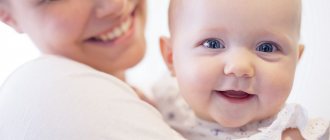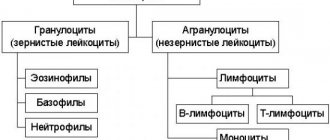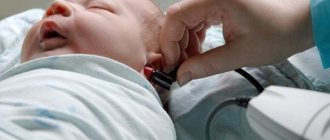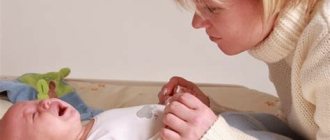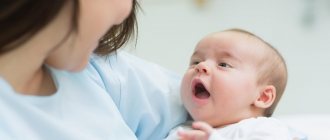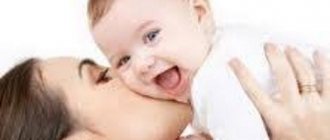A neurologist is a doctor who must monitor the health of your child at each stage of development, give advice on how to properly care for the baby, and treat if the child is sick. A visit to the doctor is necessary almost every month.
An examination is mandatory even if the baby is absolutely healthy, especially since this may not be the case. Only a specialist can identify deviations from the norm. The examination is carried out once a quarter, since the status of the newborn changes almost every month. Each segment is marked by the formation of some skills; this happens due to the continuous growth and development of the body.
In the maternity hospital
When the mother and baby are discharged from the maternity hospital, the baby undergoes ultrasonography of the brain. Brain cysts are a common diagnosis in newborns. Why this pathology occurs is not completely known to medicine. If the tumor size is no more than 5 mm, then there is no reason to worry, and the tumor will resolve by three months. If a cyst has been detected, then it is necessary to monitor the dynamics of its development every month.
The causes of central nervous system disease are:
- Pathological pregnancy;
- Complications during childbirth;
- Congenital infections;
- Injuries, prematurity.
- You should not postpone examination by a neurologist if you notice:
- Restless sleep;
- Regurgitation and vomiting syndrome;
- ZPR;
- Tremor of the arms, legs and chin;
- Paroxysms of varying duration.
Let's take a closer look at what a neurological examination is like at each stage of life.
Upon reaching one month
At one month, during an examination, the neurologist pays attention to the child’s reflexes and posture. At one month of age, innate reflexes are most obvious.
The neurologist pays attention to the condition of the muscles, since newborns are characterized by hypertonicity, the position of their body is similar to what it was in the womb: the baby draws in his legs, clenches his fists.
The muscles should be symmetrical on both sides. Different muscle tone indicates the presence of pathologies. A newborn is able to stretch after sleep when he is one month old.
The body movements of a small person are chaotic and disorderly. In the first month of life, the baby begins to focus on an object, examines it carefully, and is even able to follow its movements.
If the baby can hold his head up at two weeks, this indicates intracranial hypertension, which is treated by a doctor. During this period, the child begins to express emotions, for example, smiling when hearing his mother’s voice. It is absolutely impossible to ignore visiting a neurologist at this age.
The head circumference reaches 35 cm. In the first month, it is important to monitor growth dynamics. Every month the circumference should increase by one and a half cm. The neurologist pays attention to the condition of the fontanel.
↑ Head: dimensions and shape
Measurement of head circumference above the brow ridges: normal volume for a healthy newborn is 32-37 cm; measurement records should be compared with gestational age using centile tables to determine microcephaly and macrocephaly. Both, especially microcephaly, are associated with an increased risk of neurological pathology.
The head must be examined to determine:
- Signs of injury: fractures, hemorrhages, abrasions.
- Anterior (large) and posterior (small) fontanelles: size, bulging or retraction, premature closure.
- Sutures: overlapping of sutures (small is normal for vaginal birth), divergence of more than 5 mm (diastasis, suspected intracranial hypertension).
- Form: asymmetry of the temporal and posterior bones of the skull is observed more often during vaginal birth and persists for less than one week after birth.
- Birth tumor and cephalohematoma.
- Signs of increased intracranial pressure (hydrocephalus, infection, hypoxic-ischemic encephalopathy), intracranial hemorrhages, subdural hematoma: bulging of the large fontanelle, suture dehiscence, gaze paralysis (the “setting sun” symptom, swelling of the veins on the head).
- Craniostenosis: premature closure of one or more sutures, asymmetry of the skull. Closure of the sagittal suture leads to a change in the shape of the skull (dolichocephaly), closure of the coronal sutures leads to brachycephaly, coronary and sagittal-lambdoid sutures lead to deformation like acrocephaly (tower skull). Bone sutures detected by palpation are a sign of a high risk of psychomotor development disorders, especially for slight craniostenosis, which is genetically transmitted and is associated with other clinical signs. In this case, it is necessary to conduct an X-ray examination and consultation with specialists (neurologist and neurosurgeon).
- Craniotabes: small areas of softening of the skull bones; usually disappear within a week; if this is observed longer, it is necessary to conduct a study, since a systemic disease may be suspected (osteogenesis incomplete, congenital syphilis).
- Dark red spots: often nodular, located on the head and face in the region of the branches of the trigeminal nerve. Since they are often associated with glaucoma and cortical vascular brain damage, seizures and other neurological problems (Sturge-Weber syndrome), urgent consultation with an ophthalmologist and neurologist is necessary.
It should be remembered that in premature healthy newborns the head grows faster from the beginning of the 2nd week: in premature newborns weighing 1500 g - +0.5 cm - in the second week; +0.75 cm - in the third and +1.0 cm after the third week (blpe). Slow head growth in the first 6 months may indicate neurological damage, and rapid growth may indicate increasing hydrocephalus.
Upon reaching three months
At this stage, the baby learns to use his hands. The baby begins to study them, putting his fingers in his mouth. By three months, the newborn’s reflexes practically disappear, as the cerebral cortex begins to be responsible for regulation. The grasping reflex is replaced by conscious grasping of objects.
A three-month-old baby should be able to hold his head upright. If this does not happen, then the child is likely to have delayed physical development or hypotonia. This will be revealed during the examination.
At this age, an emotional-motor reaction directed towards an adult appears. It occurs during communication or when a new object comes into view. Children's laughter is heard more and more often in the house. The tone and tension of the flexors decreases, postures become more relaxed.
↑ 8. Symptoms of damage to the cranial nerves
For each pair of cranial nerves, we determine the functions and evaluate them.
- Sense of smell (p. olfactorii): assessed by the child’s reaction to the smell (follows with his eyes the source of the smell).
- Vision (n. opticus): Visual acuity and visual field are assessed by the reaction to a light source. From 26 weeks the baby blinks at the light, from 32 weeks he closes his eyes, from 34 weeks he follows the red ball with his eyes, from 36 weeks he reacts with nystagmus to circling and from 37 weeks he follows with his eyes. Pathological signs: lack of fixation and tracking of a moving object. Often associated with other neurological signs of generalized or multifocal brain damage; pendulum nystagmus, lack of response to repeated movements before the eyes give reason to suspect blindness; pathological changes in the fundus.
- Oculomotor function (p. oculomotorius): outward movements of the eyeball, reaction of the pupil, raising of the eyelids are assessed during examination and observation of ocular reflexes (the eyes move in the opposite direction with passive rotation of the head, maintaining fixation). It is necessary to carefully examine the position of the eyes, spontaneous or evoked movements, size, symmetry, and pupil reaction. Pathological symptoms from the pupil: asymmetry; unilateral increase or decrease in its size; change in the reaction of the pupil to light.
- Trochlear nerves (p. trochlearis): responsible for external eye movements, assessment is carried out in the same way as described above.
- Trigeminal nerve (n. trigeminus): facial sensitivity and mastication; when stimulating the corneal reflex - a grimace on the stimulated side, sucking reflex, biting fingers. Pathological sign: decreased sucking reflex, especially when it occurs in isolation.
- Abduction (p. abducens): external eye movements are assessed as III and IV. Pathological signs when assessing the motor function of the eyes: discoordination of gaze movements in the horizontal and vertical directions; restriction of eye movement; horizontal and vertical twitching; nystagmus.
- Facial nerve (p. facialis): movements and facial expression, taste (anterior two-thirds of the tongue). The position of the face at rest (palpebral fissure, nasolabial angle, angle of the mouth), the beginning, amplitude and symmetry of movements of the facial muscles are assessed. Pathological signs: weakness of facial muscles, asymmetry are associated with other neurological symptoms.
- Vestibulocochlear nerve (p. vestibulocochlearis): hearing and orientation in space; assessed by reaction to sound signals (fright, blinking, cessation of movement, breathing, opening of eyes and mouth). Pathological signs: insufficient response to surrounding sounds. Risk factors for the development of deafness: heredity, prematurity, low birth weight, prolonged jaundice, administration of aminoglycosides, furosemide, the presence of congenital anomalies, hypoxic-ischemic damage to the central nervous system.
- Pharyngolaryngeal nerve (p. glosso-pharyngeus): sucking, swallowing, sounds, taste (1/3 of the back of the tongue); assessment of the sucking and swallowing reflex (well coordinated from the 28th week of gestation, although full coordination of sucking, swallowing and breathing appears from the 32nd week) and gag reflex, contraction of the soft palate due to mild irritation of the anterior part of the tonsils.
- Vagus nerve (n. vagus): swallowing, sounds (see point IX). Pathology of the sucking reflex: decreased and impaired coordination of sucking and swallowing; important to evaluate if it is associated with other pathological features, especially hypotension.
- Accessory nerve (n. accessorius): movements of the head and neck; assessed by observing spontaneous movements. Pathological signs: congenital torticollis.
- Hypoglossal nerve (n. hypoglossus): tongue movements; assessment and examination of tongue size, symmetry, activity at rest and during movement.
At six months of age
During this period, the neurologist looks at the child’s skills during the examination. At six months, the baby should be able to roll over onto his back and stomach, raise his head, and lean on his elbows.
The child begins to recognize his parents and distinguish them from other people. The reaction to strangers is completely unpredictable: from a smile to strong crying.
At six months, the baby is able to perform simple manipulations with toys, for example, transferring an object from one hand to another. Body movements gain precision and confidence. Emotional reactions become less monotonous, the child begins to try to repeat simple combinations of sounds.
After six months, the head circumference increases by one cm. There are attempts to assume a sitting position, even with the help of adults.
↑ Estimation of gestational age
It is necessary to carefully assess the gestational age of the child, using data from the anamnesis, clinical examination, and the correspondence of mental development to morphological maturity. However, the functional maturity of the fetal/newborn central nervous system depends not only on gestational age - it is influenced by the general condition of the child and the environment.
CNS vulnerability, location, clinical manifestation and outcome depend on gestational age and birth weight. Determining prematurity, postmaturity, or low gestational weight helps medical professionals navigate the care of the newborn and predict the possibility of pathological changes in the central nervous system.
The new Bollard scale uses 6 morphological and 6 neuromuscular signs, with which, by counting the number of points, you can estimate gestational age from 20 weeks (total score 10) to 44 weeks (total score 50), the error is 2 weeks. Ideally, the assessment is carried out by two specialists, which increases the objectivity of the result.
Six morphological characters: skin, lanugo, soles, nipple areola, eyes and ears, genitals.
Let's take a closer look at the methodology for assessing 6 neuromuscular signs:
- Posture - spontaneous posture of a newborn (compare in the table).
- Wrist “square window” - gently bend the newborn’s hand at the wrist joint as far as possible, measure the angle between the palmar surface and the inner surface of the wrist and check the table.
- Return of the arms - bend your arms at the elbow joint and hold in this position for 5 seconds, release and note the degree of their spontaneous return according to the table.
- Popliteal angle - raise the lower limbs, bend the knees gently, but as far as possible, pull them to the chest, measure the popliteal angle and compare with the table.
- The sign of a “scarf” is to try to place the child’s hand behind the neck as far as possible and compare it with the table.
- “Heel to ear” - raise your legs bent at the hip joints and pull them towards your ears, compare with the table.
All 6 presented signs characterize muscle tone, which will be described below.
Older children
During the examination, the neurologist pays attention to the baby’s ability to sit without support and evaluates physical development. Children at this age begin to crawl and stand up.
As for fine motor skills, the child is already able to hold an object with two fingers. The child parodies the movements of adults: waves his hand, claps his hands. The baby knows well who his mom and dad are and is wary of strangers. The baby understands that this is impossible, can find the desired object among others, and understands the meaning of the spoken words.
An examination at one year of age cannot be ignored, because the baby begins to become a full-fledged person. At the age of one year, many children are already able to move independently, some take their first steps holding a parent’s hand.
In the year and third month, every healthy child should be able to walk. The ability to sit at the table becomes better: the baby holds cutlery, eats with them, and knows how to drink from a mug.
The development of the cognitive sphere occurs by leaps and bounds: the child knows the names of objects, parts of the human body, and the sounds that animals make. By this time, the head circumference increases by ten cm.
Child 1 year old Sample menu
- 7.00 - Breakfast: Porridge 150-180g, Milk (kefir) 70-100g.
- 10.00—Second breakfast: Juice 80-100g and cookies.
- 13.00 - Lunch: Soup (with meat 50g) 150-180 ml, A piece of bread, Compote or jelly 70-100ml Soup with vegetables in the form of soft pieces (mash with a fork). You can prepare soup for everyone, taking into account the child’s needs: do not overcook vegetables, but simply add them to the soup during the cooking process, use lean meat, do not add hot seasonings and sauces, add light salt.
- 16.00 - Afternoon snack: cottage cheese 50-70g. Fruit puree or fresh fruit 50-100g. Kefir (milk) 70-100g.
- 19.00 - Dinner: Vegetable puree 150-180g. Bread. Compote 70-100g.
- If necessary, before bedtime, you can breastfeed the baby or give him 200g of the formula to which he is accustomed.
SIMILAR ARTICLES:
- Newborn first examination at the clinic Newborn first examination at the clinic….
- Child development 7 - 9 months Examination Neuropsychic and physical development...
- 3 months examination of the child in the clinic Vaccinations At 3 months examination of the child in the clinic...
- How to get tested for a child Urine Blood How to get tested for a child? Such...
- Attachment to the clinic Form Attachment to the clinic is mandatory...
The most common questions parents ask a neurologist
What causes constant tension in the limbs?
Hypertonicity is a normal phenomenon inherent in all newborns up to a certain age. Babies bend their arms, press them to their chest, clench their fingers tightly into a fist, and the thumb lies under the others. The lower limbs are also bent, but less than in the arms.
Dads and moms may notice that the tone changes; if you turn your head to the left or right, the muscle tone will become higher on one side. This feature of the child's body is called muscular dystonia. But don’t be afraid of medical terminology; this condition is considered absolutely normal.
By four months, muscle tone becomes less and less, and many muscle groups are used when moving. Hypertonicity cannot be treated in any way, but it is permissible to do a massage that promotes the harmonious development of the body. Advice on how to do a massage should only be given by a qualified specialist. During the examination, the doctor will tell you if there is cause for concern.
Is tremor of the limbs and chin a sign that the child is cold or something wrong with the nervous system? Is it necessary to visit a doctor?
Trembling in the body, or scientifically called tremor, occurs in the first stages of life. The reason for this is the incompletely formed central nervous system. Tremor occurs due to emotional shock, physical stress, but sometimes the attack begins suddenly. Trembling can occur on both sides or on one. Young mothers worry in vain when they notice trembling in the child’s body. If the tremor repeats periodically, each time becoming longer and more intense, then this is a reason to go to an appointment with a neurologist.
What is the sucking reflex? Why does a child constantly suck something: fingers, a pacifier, a breast? Maybe he's hungry?
The sucking reflex is one of the main ones in children under one year old; it is innate. Any irritation of the mouth causes sucking movements in the newborn. The reflex ceases to manifest itself when the child reaches four years of age. In infants, there is a search reflex, as well as a proboscis reflex. While eating, these reflexes intensify, but this does not mean that the child wants to eat.
Why does the child twitch and throw his arms to the sides? Is it necessary to see a neurologist?
This behavior of the child is explained by the Mohr reflex. It persists for up to six months and often occurs when changing body position or loud sounds. If you pick up a baby from the crib and then put it back, the baby will involuntarily raise his arms up. Sometimes the Mohr reflex occurs involuntarily or as a response to knocking, screaming or clapping. Such hand movements are common to all babies; it is not their presence, but their absence that should cause concern. But upon reaching 5 months, the reflex should disappear.
What causes frequent regurgitation? Is there a need to seek help from specialists?
Regurgitation up to five times a day is the norm, not a neurological disorder. This is especially common in the first month of life. Regurgitation is associated with the structural features of the gastrointestinal tract and its functioning: the ventricle is located horizontally, has the shape of a circle and a very small volume, no more than ten mm. Therefore, babies can fill up on small amounts of milk. The cardiac sphincter of the stomach is small in size, and the entrance to the stomach has a larger diameter. Because of this, food moves slowly through the gastrointestinal tract.
Regurgitation is also promoted by:
- Excessive amount of food;
- Prematurity;
- Underweight;
- The breathing process is still imperfect;
- Lack of digestive enzymes;
- Swallowing air while eating;
- Short intervals between feedings.
What is that white line on the baby's eye? Why does she appear?
This phenomenon is called Graefe syndrome. The presence of a stripe between the iris and the eyelid does not indicate the presence of any pathologies; it occurs quite often in newborns.
It occurs due to changes in body position, changes in lighting, and also simply due to the individual characteristics of the body. The immaturity of the nervous system also contributes to its formation.
Graefe's symptom goes away on its own within six months. But if the symptom is accompanied by strabismus, high excitability, mental retardation, then you should immediately visit a neurologist for an examination.
Why does a child hit his head?
Small children sometimes start banging their heads against objects around them. Scientists do not fully know what causes head shaking in children under 3 years of age. It is believed that in this way babies train the vestibular apparatus and calm down. You've probably noticed that shaking your head ends up falling asleep.
Sometimes children bang their heads to attract attention and express protest. In psychology, this syndrome is called “self-punishment.” A child hits his head so that mom and dad will feel sorry for him. Such behavior can be avoided if direct prohibitions are not made. To prevent head banging from causing serious physical harm, you should remove dangerous objects away from the baby.
Neurological hammer
Question: Why does a neurologist use a hammer? (knocks the hammer on the knee and moves it in front of the child’s eyes?)
An integral attribute of a neurologist is a neurological hammer, also known as a Taylor hammer, a percussion hammer (percussion is tapping in medical parlance), a tomahawk, a Buck hammer, and a Tromner hammer. There are a lot of varieties of tools, everyone chooses what is most convenient for them.
Despite the simplicity of the mechanism and the prejudiced attitude of many patients towards it (“what can you understand by hitting your knee with a hammer?”), the neurological hammer is a serious diagnostic tool. It allows you to effectively identify all kinds of abnormalities in the functioning of the nervous system in the early stages: the condition of the oculomotor nerves, vestibular apparatus and cerebellum of the baby, and accordingly prevent the development of serious neurological diagnoses. There is no need to be afraid of the instrument, even despite the presence of needles on some models - they are designed to test reflexes and sensitivity of the skin and will not cause pain to the child.
Medicines prescribed by a neurologist
A medicine with citral is a drug that a neurologist prescribes for newborns. The mixture received very different reviews from parents: some speak negatively about its therapeutic effect, while others praise the healing properties of the drug. If your doctor has prescribed this medicine, you should read the reviews before taking it. The mixture contains components identical to those found in citrus fruits, eucalyptus and lemon balm. The mixture has a calming effect on the child and normalizes blood pressure. Reviews say that the mixture even reduces ICP.
The mixture often contains motherwort and valerian, which are famous for their calming properties. But reviews indicate that you should be careful with these plants, because they very strongly depress the nervous system. The mixture contains:
- Diphenhydramine;
- Glucose;
- Purified water that does not have any impurities;
- Sodium bromide.
Doctors prescribe medications containing Magne B6 to children. Reviews from moms and dads indicate that these medications have a beneficial effect on the baby’s fragile nervous system. If a pediatric neurologist has prescribed Magne B6 for a newborn, keep in mind that it has a laxative effect.
↑ 9. Primary functions
This refers to functions that require integration with the cerebral cortex:
- Interaction with others and social contacts.
- Behavior.
- Feelings, perception as an assessment of the reaction to light touch, pain, light, sounds. This has already been discussed above, but it should be emphasized that in an overall adequate response to stimulation it is necessary to take into account:
- there is a latency period between stimulation and response;
- decrease in the intensity of the reaction if stimulation is repeated (habituation);
- possibility of response modulation; on the other hand, an inadequate response without a latency period, habituation and stereotype may be a sign of cortical damage.

